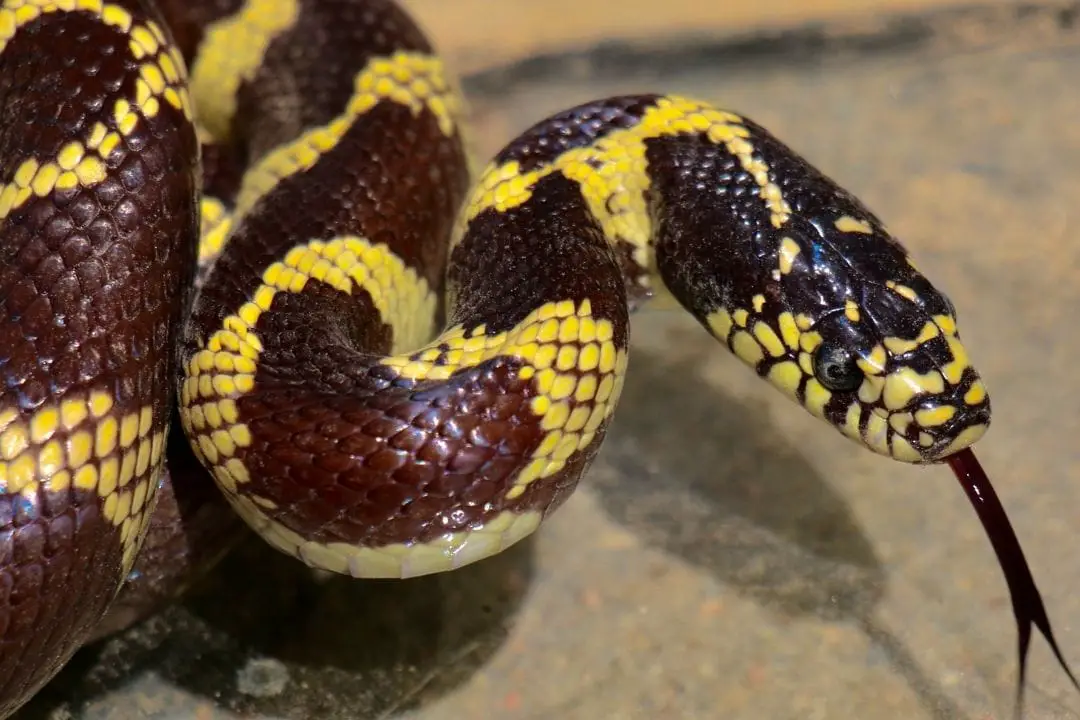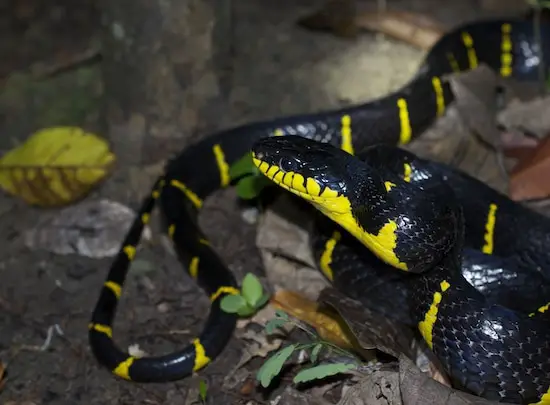Black and yellow snakes are some of the most visually striking serpents found across the Americas. Their vibrant coloration makes them stand out against natural backdrops of soil grasses leaves and tree trunks.
While many associate black and yellow snakes with danger and venom, not all of these reptiles pose a threat. In fact, the majority of black and yellow snake species are nonvenomous and harmless to humans. Even some of the venomous ones typically avoid confrontation if given a choice.
By understanding the key differences between benign and dangerous black and yellow snakes, you can appreciate their beauty without undue fear. Read on to learn more about these captivating reptiles, including how to identify venomous species and safely view or handle docile snakes.
What Makes Snakes Black and Yellow?
A snake’s coloration serves multiple purposes, from camouflage and signaling to temperature regulation. Some traits are inherited genetically, while others stem from environmental factors.
For example, certain pigments like melanin and carotenoids produce black and yellow hues in snakes. Their patterning results from concentrated pigments in specific skin cells. Some develop brighter colors when consuming prey rich in carotenoids.
Snakes may also adapt their colors to mimic surroundings like sun-baked leaves or lichen-covered bark. This camouflage lets them ambush prey and evade predators.
Alternatively, vivid yellows and blacks can signal toxicity, warning potential predators of danger. While mimicking venomous species, some harmless snakes deter predators through deception.
Most Common Black and Yellow Snakes
From garters and rat snakes to vipers and coral snakes, numerous serpent species exhibit black and yellow coloration. Here are some of the most frequently encountered in the United States:
Garter Snakes
Garter snakes rank among the most ubiquitous serpents in North America. They thrive in a variety of habitats from woodlands and prairies to backyards and parks. Their black or brown bodies sport a yellow or white stripe down the center. Nonvenomous and docile, these small snakes often become victims of mistaken identity.
Corn Snakes
A wildly popular pet snake, corn snakes have reddish-orange blotches on a black background. Selective breeding has produced many color variations, including black and yellow banded morphs. Another nonvenomous species, corn snakes pose no danger to humans. Their name comes from a historical association with rodent-infested corn cribs.
Milk Snakes
From deserts to forests, milk snakes range across North and Central America. They exhibit banded red, black and yellow markings that mimic deadly coral snakes as a defense mechanism. Completely harmless to humans, milk snakes got their name from a fable about sucking milk from cows.
Kingsnakes
The kingsnake family includes some 50 species, most readily identified by black or brown skin with yellow or white bands or speckles. These powerful constrictors subsist on a diet of rodents, birds, eggs, lizards and other snakes – even rattlesnakes! Kingsnakes are nonvenomous and typically docile when handled.
Gopher Snakes
Also known as bullsnakes or pine snakes, these heavy-bodied serpents can reach up to 8 feet long. Markings range from yellow or white speckles to blotches on a brown, gray or black hide. Their affinity for burrows earns them the name “gopher snakes.” Though often mistaken for rattlesnakes, gopher snakes are nonvenomous.
Venomous Black and Yellow Snakes
While less common, venomous black and yellow snakes deserve a cautious eye. These include:
Coral Snakes
Reclusive coral snakes brandish the infamous red, yellow and black banding mimicked by harmless milk snakes and kingsnakes. These shy but highly venomous snakes deliver toxic bites that can be fatal without prompt medical care. Various species inhabit southern North America and Central America.
Rattlesnakes
About 30 species of rattlesnakes live in diverse regions of the Americas. They brandish hinged fangs and venomous hematotoxic bites. Different rattlesnakes exhibit blotchy patterns with hints of black, yellow, brown, gray and more. Most can be identified by their namesake warning rattle.
Water Moccasins
Also called cottonmouths, water moccasins frequent swamps and wetlands of the southeastern United States. These pit vipers sport heavy black bodies marked by yellow, brown or olive banding. With hemotoxic venom, water moccasins are quick to bite when threatened – hence the nickname “cottonmouth.”
Yellow-Bellied Sea Snakes
Though seldom encountered by humans, yellow-bellied sea snakes exhibit vivid black and yellow banding. They inhabit warm coastal waters from the eastern Indian Ocean to the western Pacific. Able to remain underwater for hours, these venomous snakes prey primarily on fish. Only a few recorded bites have proven fatal.
Identifying and Viewing Snakes Safely
-
Observe from a distance – Give any unfamiliar snake plenty of space and don’t approach or disturb it. Snakes only bite in self-defense.
-
Look for key features – Triangular heads, pronounced necks, slit-like pupils and rattles can indicate venomous species. Nonvenomous snakes typically have rounded heads/bodies and round pupils.
-
Research local species – Learn to identify regional venomous snakes, along with harmless lookalikes. This helps avoid negative encounters.
-
Leave snakes be – Resist the urge to capture or kill snakes. They help control rodents and pests. Alert authorities about any venomous snakes in populated areas.
-
Stay calm if bitten – While rare, bites can occur when stepping on or handling snakes. Stay calm and seek prompt medical care. Provoking or attacking snakes greatly increases bite risk.
Safely Handling Docile Snake Species
For nonvenomous snakes like garters, milk snakes and kingsnakes, calm handling allows enjoyable interaction without harming the animal. Follow these tips:
- Allow snakes to move through open hands to avoid constriction.
- Support the body to prevent injury if the snake thrashes or falls.
- Move slowly and avoid squeezing when grasping snakes.
- Do not touch head or tail areas to prevent biting.
- Thoroughly wash hands after handling any snakes.
- Carefully return snakes to their native environment when finished.
When treated with proper caution and respect, even the most fearsome serpents can be observed and appreciated from a safe distance. Their dazzling black and yellow patterns attest to nature’s palette – warning some while welcoming others.

Yellow and Black Snake Identification
Here are some yellow and black snakes with photos for most. If you don’t find the snake here – will you leave a comment or send a photo to us so we can try to identify it?
Mangrove Cat-eyed Snake

This black and yellow snake is native to Southeast Asia. It is a colubrid (rear fanged) with a mild venom that doesn’t affect most people. Bites by this snake are not known to have been deadly in the past. This snake is sometimes confused with the Banded Krait, but you can see in #2 below, they really don’t look much alike.
Black and yellow snakes
FAQ
Is a black and yellow snake poisonous?
The black and yellow snake is vibrant and eye-catching, and it’s not just for show. In the animal kingdom, bright colors often serve as warnings to potential predators. But not all black and yellow snakes are venomous; some just like to look the part.
Are black and yellow garden snakes poisonous?
- Garter Snakes are non-venomous: While some garter snakes have a mild venom that helps them capture prey, it doesn’t pose a threat to humans.
- Garter snakes are harmless: Bites from garter snakes are generally harmless to humans and other large mammals.
- Garter snakes are shy and avoid people: They are generally shy and avoid direct contact with people and pets.
- Garter snakes may bite defensively: If handled or threatened, they may bite, but the bite is not venomous and is generally harmless.
- Garter snakes can be found in many places: They are common in North America, often in suburban backyards or along creeks and ponds.
- Garter snakes can be identified by their stripes: They usually have two yellow stripes down their dark bodies.
What is the black and yellow snake in my yard?
Sometimes mistakenly called a “garden snake,” garter snakes get their name from a female under garment, the garter belt. They sport long, yellow stripes down the length of their green, brown, or black bodies. Sometimes, their stripes are not well defined and appear to be more checkered than a prominent line.
What is the saying about black and yellow snakes?
-
The Rhyme:The rhyme “Red touches yellow, kill a fellow; red touches black, friend of Jack” is a mnemonic device used to distinguish the venomous coral snake from non-venomous snakes like milk snakes.
-
Coral Snake:The coral snake, a venomous snake, has bands of red, yellow, and black, with the red bands always touching the yellow bands.
-
Milk Snake:Milk snakes, which are harmless (except to other snakes), have the same color bands, but the red bands always touch the black bands.
-
Important Note:Wildlife-Removal.com notes that this rhyme is specific to North American snakes and may not apply to other regions where coral snakes have different color patterns.
-
Safety First:If you encounter a snake and are unsure of its species, it’s always best to leave it alone and avoid any interaction.
What does a black snake with yellow stripes mean?
Its range stretches from southern New Jersey in the east to Oregon in the west If you find a black snake with long yellow stripes in your backyard, it’s most likely a garter snake. A black snake with yellow rings or bands will likely be a kingsnake of some kind, depending on where you are in the country.
Are black and yellow snakes venomous?
Black and yellow snakes can be both venomous and non-venomous, depending on their species. The color alone isn’t sufficient to determine if a snake is venomous. However, some of the most venomous black and white snakes are known to be very dangerous and even fatal when they bite. Non-venomous black and yellow snakes are dominant.
What is a yellow-bellied sea snake?
Yellow-Bellied Sea snakes are some of the most common snakes around the world. Their base colors are black and yellow. These snakes have a black body with a yellow underside. Colorful and easy to spot, they aren’t as easy to see as they live out in the sea, far from the shore.
Are there black snakes with yellow patterns?
But that is not all. There are dozens more of subspecies of such black and yellow snakes – black snakes with yellow patterns, yellow snakes with black patterns, you name it, they’re out there. Coloration and pattern vary so much in the serpentine world, and with such variance comes a new lexicon.
Are black snakes venomous?
These snakes typically have a sleek black body, but some species show faint yellow markings. While neither bright yellow nor venomous, this black snake is a formidable predator in its own right.
Are black and yellow snakes carnivores?
Black and yellow snakes are common in the US. Some snakes are mostly black and yellow while others are found in these colors under their various morphs. These snakes grow to different sizes from just a few inches up to a few feet. Black and yellow snakes are predatory which means they are carnivores.
